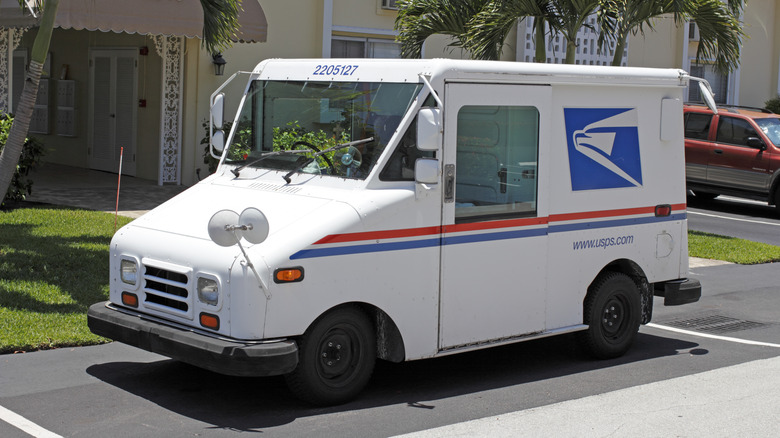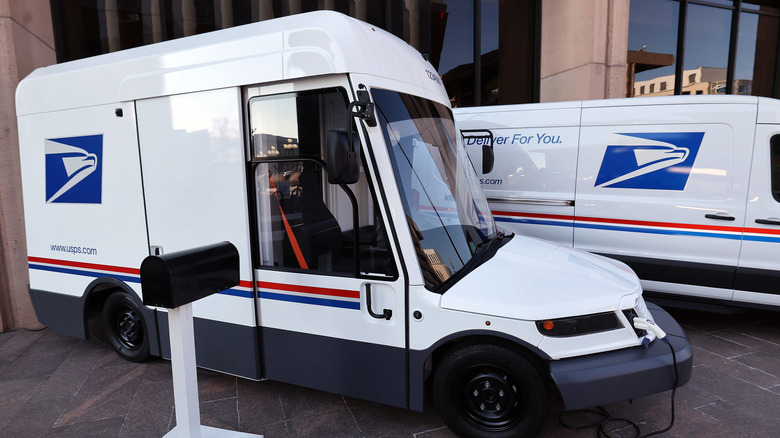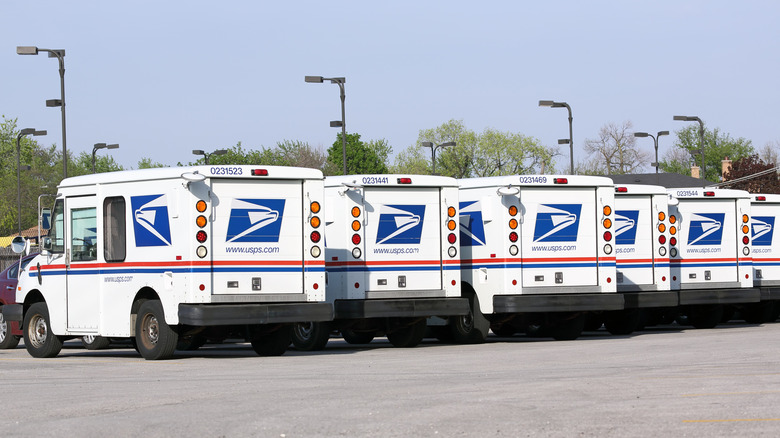The Reason Why Mail Trucks Don't Have License Plates
If you've ever been stuck behind a mail truck in traffic, you may have noticed that it doesn't have any license plates. Although a near-universal requirement for everyone else on the road, the United States Postal Service (USPS) operates under a different set of rules. So, what's so special about the USPS? On its website, USPS states, "Congress afforded the Postal Service broad powers of operation in the marketplace, excluding it from most Federal laws and regulations." While USPS is exempt from many federal laws, including vehicle registration and procurement regulations, laws like OSHA workplace safety regulations and anti-discrimination laws still apply to USPS operations.
The lack of license plates isn't the only unusual thing you might have spotted on a mail truck. Unlike most US cars, many USPS vehicles have the driver's seat on the right-hand side. This is designed to make mail delivery more efficient and safer as it allows mail carriers to easily access mailboxes along the curb without exiting the vehicle. Left-hand drive isn't a legal requirement for ordinary drivers, though, whereas state-issued plates certainly are.
Every USPS truck has an identification number
Just because a mail truck doesn't have a license plate, it doesn't mean it's difficult to identify. Instead of plates, mail trucks have a unique serial number printed on their front and rear. These seven-digit numbers enable the USPS to track and manage the vehicles, enabling mechanics and postal workers to log service records, report mechanical issues, and track vehicle history efficiently. It's also used in cases of road accidents, traffic law violations, and theft so law enforcement agencies and USPS officials can identify the specific vehicle involved. Mail trucks are also pretty easy to identify due to their distinctive shape and branding.
Most USPS mail trucks are Grumman Long Life Vehicles (LLVs), which have been the backbone of the postal delivery fleet since the late 1980s. Manufactured by Grumman Aerospace Corporation between 1987 and 1994, these trucks were specifically designed for mail delivery. An interesting fact about the seven-digit number is that you can tell how old a truck is by its license number. The first digit of a USPS truck's serial number reveals its age, with numbers 7 through 4 indicating production years from 1987 to 1994. As even the newest LLVs have been in service for over 30 years, USPS has begun phasing them out and replacing them with Next Generation Delivery Vehicles (NGDVs) with improved efficiency, safety, and comfort. NGDVs are also exempt from needing license plates.
Federal laws don't apply to the USPS
USPS trucks haven't needed license plates since the Postal Reorganization Act of 1970, which was signed into law by President Richard Nixon. The law changed the old Post Office Department into an independent agency of the federal government and renamed it the United States Postal Service. It states that "No federal law dealing with public or Federal contracts, property, works, officers, employees, budgets, or funds shall apply to the exercise of the powers of the Postal Service." This exemption allows the USPS to establish its own policies regarding vehicle identification, eliminating the requirement for standard state-issued license plates.
However, not having regular license plates doesn't mean USPS trucks aren't closely regulated. USPS vehicles are exempt from state vehicle insurance laws and are self-insured, meaning the USPS assumes financial responsibility for any incidents involving its vehicles. This is feasible due to its vast scale and resources, which enables it to manage risks internally without external insurance policies.
There are some exceptions to vehicles covered by the Act. If you live in a rural area, sometimes your mail will be delivered by a Rural Carrier Associate who often provides cover for mail workers and will likely use their personal vehicles for deliveries. They need to display license plates and buy insurance just like everybody else.


